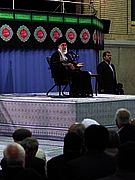Khamenei’s Office Issues Warning: No Misrepresentation
» Addressing Media and Political Activists:
The office of the supreme leader of the Islamic republic of Iran published a statement on its official site warning about “misunderstanding” and the “juxtaposition of main and secondary” themes of ayatollah Khamenei’s remarks. It also asserted that this was a “tactic used by the media of enemies, malevolent factions and the weak spots of enthusiasts.”
The official website of the leader of the Islamic regime posted this note in its “Special Bulletin” for ayatollah Khamenei’s recent trip to the province of Khorasan. The site wrote that ayatollah Khamenei’s trips to the provinces are “a media event” and warned that “without proper coverage, they will significantly lose their political-social effectiveness.”
Iran’s leader normally takes one or two annual trips to difference provinces of the country and meets the residents of various towns, including government and state officials. His speeches during these trips constitute a key element of the trip.
Iran’s state-run national radio and television which operates under the direct supervision of the supreme leader, and other state media outlets, normally allocates much of their writing to these provincial trips prior to their commencement. As the trip begins, the coverage reaches its peak when the bulk of the radio-television network programs are devoted to the event. Video images of people and the youth passionately and emotionally welcoming ayatollah Khamenei and sitting to listen to his speeches, repeated replays of excerpts of the leader’s talks are parts of these broadcasts.
Like the Visits of the Prophet
The media in the Islamic republic of Iran uses these trips to portray the image that the supreme leader is exceptionally popular among ordinary people across the country, signifying a bond between society and the regime.
This type and level of propaganda has become more routine since the protests that followed the disputed 2009 presidential elections when massive and unprecedented demonstrations erupted across Iran and when demonstrators chanted anti-regime slogans.
Morteza Adib Yazdi, a cleric close to ayatollah Khamenei and a teacher at the influential Qom Theological Seminary has said that the trips that ayatollah Khamenei undertakes to visit the provinces of the country are reminiscent of the trips of Prophet Mohammad, including his famed one to Medina.
In its most recent note, the office of the supreme leader wrote that ayatollah Khamenei’s trips “provide propaganda and discussion opportunities for the Islamic revolution” and therefore “require that special attention be paid to the propaganda and discussion atmosphere of society” that is created through his remarks.
According to this official site of the leader’s office, “juxtapositioning key elements of the speech for secondary ones, carelessness by individuals and friendly media, and even the positions of some malicious individuals inside the country” provide fertile ground for the “enemies of the regime” to focus on the secondary aspects of his remarks on one hand, and boycott and diminish the central elements of his remarks on the other.”
In its warning, the site cites some examples when such bias has taken place and names Khamenei’s speech at the non-Aligned meeting in Tehran two months ago, his speech in Qom when he called the opponents of the regime “political microbes,” and his speech in Kermanshah when he spoke about the possibility of changing the political organization of the country, i.e., changing the system from a republic to a parliamentary system, as examples of this “misrepresentation,” warning political and media activists to refrain from repeating such activities.
The article concludes by saying that one of the best services that media activists can provide is to introduce the main purpose and subject of these trips by the leader and the standard for that is “the centrality of meetings with people, the youth and students during these trips.”


